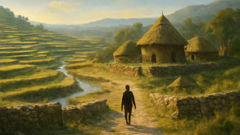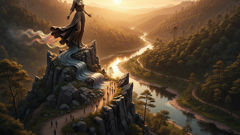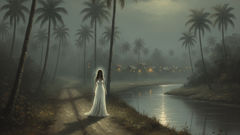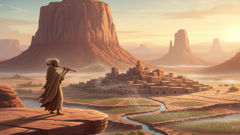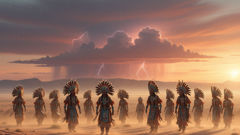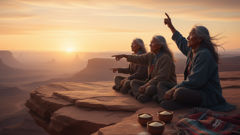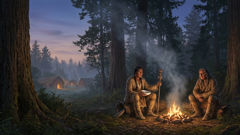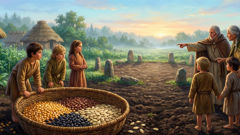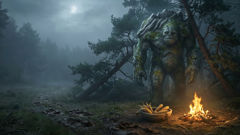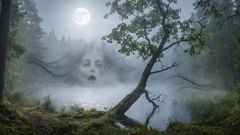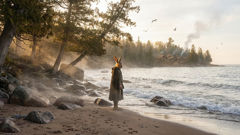Introduction
The first lines of the sun were not written in ink but traced across the hills by a quiet wind. The early mornings in the eastern cordilleras did not announce themselves with fanfare; rather, they slipped through the cloud forest like a careful visitor, laying copper light on maize leaves and on the faces of weavers, farmers, healers, and judges. In the stories of the Muisca, Bochica is not merely a man but a current—an invisible hand that nudges a people toward order, toward a calendar of justice as real as the river that refuses to forget its bed. This is a tale of when earth and law learned to walk together. It begins with a river that ran too angry to be crossed, with a village that tended its crops as one would tend a fragile secret, and with a traveler who arrived not with noise but with a patient, stubborn wisdom. Bochica comes from beyond the mountains, sauntering through the fog like a figure carved from grain and sun. He listens first, shaping his words to the rhythms of the land. He speaks not merely to persuade but to mend a broken weave—between priest and farmer, between elder and child, between the law and the land that sustains it.
The Muisca people had long remembered the old tales of a sun that spoke through the river, a guardian who would teach them to read the weather in the leaves and to live by a code that could be counted, measured, and defended with courage. Bochica’s wisdom was not a sudden flood; it was a careful irrigation, a channel carved through stubborn rock. He carried no sword, only a staff carved from the wood of the sacred ceiba, and with it he mapped a pathway for the people—an arrangement of fields, channels, calendars, and laws that could be taught and learned from one generation to the next. He did not destroy what was good in sacrifice; he re-sculpted it, turning fear into responsibility and hunger into cooperation. The myth is generous with its details: there are rivers that widen when Bochica speaks, there are birds that pause in their flight to listen, and there are bridges of shivering rope and woven sap that stretch over gorges to join villages that had learned to speak in a few shared gestures of need.
In this telling, Bochica’s arrival is not a single moment but a season of transformation. The hero does not conquer the land; he harmonizes it. He asks the people to look beneath the soil where corn struggles to rise, to measure the rains, to treat the seasons as a library with shelves of seed and soil. From his lips flow rules not written in stone but carved into memory—codes that would become the very habit of the Muisca: fairness in dispute resolution, a respect for elders that never dissolves into arrogance, a regard for neighbors that transcends family ties, and a humility toward the plants and rivers that sustain life. He teaches how to plant maize in a way that the roots grasp the earth as if it were a friend, how to irrigate with canals that remember the shape of the land, how to rotate crops so the soil does not forget its own name.
This is a story about listening—listening to the river’s voice when it rises in flood, listening to the mother who speaks softly about hunger and hope, listening to the child who asks why the world must bend to greed when it could bend to mercy. Bochica does not pretend to know every answer, but he offers a practice: a rhythm of law, a cadence of harvest, a ceremony of harvests that binds people to the ground and to one another. His laws are not tyrannies but tutors; they teach the hows and whys of living together: how to settle quarrels before the night grows old, how to share the food stored for the dry season, how to honor the earth that feeds all. And so the myth unfolds—the farmer learning to listen to the soil, the judge learning to listen to the seed, the child learning to listen to the elder. The mountains listen too, and in their listening there is a quiet, almost sacred, agreement that the valley will never again be a place of mere survival but a university of belonging. Bochica’s journey is marked by maternity of the land—by rains that anoint the corn, by sun that blesses the harvest, by the patient arithmetic of seasons that teaches a people to calculate care as precisely as they count days in the calendar.
What follows are the long breaths of a civilization taking shape: laws drafted not in a palace but in the common house where families debate and decide, fields shared and rotated, festival dates aligned with the celestial board. Bochica’s most enduring gift is not a monument but a habit of looking after one another—the practice of justice enacted in riverside courts, the morality taught in the schools of the village, the reverence for the ancestors that keeps memory from becoming mere nostalgia. If you walk the high valleys today and listen to the old stories, you will hear Bochica’s steps echoing in the footfalls of farmers at dawn, in the careful hands of weavers who count threads as if they’re stars, in the discreet sigh of mothers who worry about droughts yet trust the seeds. The myth is a map to more than a homeland; it is a map to responsibility, a reminder that civilizations are not built by force alone but by the patient integrity of daily acts—by waking before the sun to water, by giving shelter to the stranger, by teaching the young to tell truth in a world that would rather have convenient fables.
So this tale invites you to walk with Bochica into the fields and the temple, to listen as he negotiates the rough edges of a changing society, to witness the moment when a people choose to govern themselves with wisdom rather than fear. It is a story about how a single life can stitch a nation together long enough for the next generation to learn to sew it anew. And if the stones in the path feel heavy, remember that the mountain does not grow tired of telling stories; it grows tired only when no one is listening. Bochica’s legend endures because it answers a simple question with a layered, generous reply: What happens when a civilization decides that beauty lives in fairness, that nourishment lives in shared labor, and that the law begins wherever two hands meet and agree to tend the same field?
Section I: The Arrival and the First Laws
In the breath between night and day, Bochica appears at the edge of a village cradled by river and rock. He does not burst into song or shout a decree; he tests the air, senses the hunger of the people, and asks questions that cut through the fog of old grievances. He asks farmers what their fields demand of them, what the river asks of the land, what the elders fear will be lost if the village drifts without a common code. The answers are not given in triumph but in the careful, stubborn patience of listening. The myth’s oldest scene is not a conquest but a council: a circle of men and women, of elders and young apprentices, debating the problem of the drought when the maize darkens at the tip and the ears do not fill. Bochica does not speak until he has counted the sun’s hours, watched the clouds gather at the far ridge, and traced the shadow of the cuyabro mountains across the floor of the plaza.
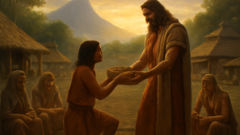
He proposes a system: three channels to bring life to the field where the soil refuses to yield without a hand guiding its thirst. He lays out a calendar for planting and harvest, aligning seed work with the moon, the rains, and the earth’s own memory of previous seasons. He teaches that water, like mercy, must be shared and limited by consent; a farm cannot be a fortress of one, nor a temple a vault for a few. The seeds are divided with care, not hoarded as if life were a coin collected in a purse. The people learn to rotate crops, to keep the soil generous enough to feed the next generation. Bochica’s law becomes a patient argument, a sequence of small rituals that bind the village together: the sharing of harvest at the end of the dry season, the assembly to decide what to plant when the rains return, the tradition of inviting a stranger to eat with the family as a reminder that hospitality is the first form of justice.
As weeks turn to months, the fields begin to answer with color and texture: the maize stands taller, the beans curl toward the sky like a chorus of green, the tubers hold their earth in a careful grip that does not exhaust the ground. The village learns that a rule is a bridge, not a wall. Bochica’s voice becomes a thread that holds the fabric of life in place—the law of turn-taking, the law of shared labor, the law of droughts endured with a plan. There is a ritualized moment when the river is coaxed to disgorge new life: a procession to the water’s edge, offerings placed on the stones where the current slows, prayers spoken with the quiet confidence that the land remembers those who honor it. The people begin to see that the law is not a prison but a garden fence that keeps the corn from wandering away. When disputes arise about land boundaries, Bochica invites the parties to his field, where the soil itself becomes a witness. They measure not only the inches of land but the trust that makes such measurements possible.
In the mornings, the sun climbs over the shoulder of the mountain and casts long, gold-tinged shadows over the terraces. The children learn to watch their elders, to ask questions, to see the birds that hover above the newly planted rows. Bochica teaches that wisdom is not a possession to be stored but a river to be shared. Each farmer who chooses to follow the new order writes a small verse into the larger song of the valley—an arc of words about balance between necessity and generosity, about the humility required to accept that law comes alive only when people remember it in the field. This section closes with a quiet moment when a girl who once doubted the value of law plants the first seed in a canal bed that will feed the village for months. Bochica nods, not with triumph but with the solemn satisfaction that a seed has found its home in a law that respects the soil and the neighbor alike.
Section II: The Harvest, The Moral Charter, and The Long Night of Drought
The second section begins not with triumph but with the hard, stubborn test of time. The harvest comes as a patient mercy, slow and generous, yet not guaranteed. Bochica’s laws survive the test of droughts because they are not merely rules but a way of listening to the land’s signs. When a harsh dry season settles over the valley, the people do not scatter; they gather. Bochica teaches that justice is not a verdict but a rhythm—the cadence of shared work, of water saved in winter and released in spring, of households supporting one another when crops fail. The characters in this part are not only farmers but healers, weavers, and storytellers who remind the village that memory itself can be a harvest you store for winter’s hunger.
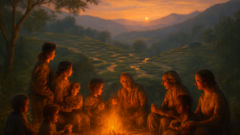
A festival appears in the myth as a way to codify gratitude and restraint. The festival of the fifth moon marks the transition from fear to calculation: people bring offerings to the river, recount their losses, and vow to work together to restore fields, to distribute grain, and to write the next year’s calendar in a way that makes room for every family. Bochica’s influence extends beyond the plow and the loom; it enters the agora where disputes are resolved with fairness rather than force. The law transforms from a set of commands into a shared ethic—an everyday practice of care: tending to elderly neighbors, sharing blankets when the nights grow cold, teaching children to recognize the plant’s language—the leafy sighs of the maize, the careful tapping of the cassava’s fibrous heart, the braids of the river that bind one valley to another.
The climatic trials test Bochica’s most cunning achievement: not new tools but a moral architecture. He insists that the people not only measure the land but measure their own desires—how quickly fear becomes violence, how easily pride becomes self-denial of obligation. The heroes of the myth are not invincible; they are patient, and their strength is that they refuse to turn away from the long work of civilization. They learn to live with scarcity as a teacher, to honor the dead by tending the living, and to imagine a future where the fields yield enough for both festival and famine. When the drought ends, the valley breathes a surplus of light. The terraces, once barren, become an amphitheater of color—golden stalks catching the sun, vines heavy with fruit, the air sweet with smoke from cooking fires that have learned to burn cleanly in the new, communal kitchens.
The final pages of Bochica’s myth are not a conclusion but a doorway. He does not declare the world perfect; he leaves behind a practice—an education in how to read the land, how to listen to the weather, how to negotiate with one another so that every voice can be heard while the river remains unfired by human anger. The village becomes a living testament to a law that grew from the earth’s own patience: that a society is strongest when its people share the work, share the food, and share the responsibility of keeping faith with the soil and with each other. The legend persists because it offers a gentle paradox: civilization is not a triumph over nature but a marriage with it, a constant negotiation between need and mercy, a lasting vow to ensure that the next generation inherits more than land—they inherit a way of living that makes the land worthy of their care.
Conclusion
Bochica’s legacy is not a single statue but a living curriculum written into daily life. The people remember him most when they wake before dawn to tend the fields and when they pause to count what they owe to one another: a fair share of seeds, a listening ear, a promise kept to the young who ask why the world must change. The myth invites readers to see civilization as ongoing work, a discipline of care embedded in soil, water, and word. If you walk the ridges of the Andes and listen to the wind sift through the maize, you can hear Bochica’s old, patient advice in the leaves: that power without mercy breeds hunger, that law without love is empty, and that the greatest harvest is the one we keep by feeding each other’s hope. The story closes with a future that is not merely possible but probable, provided that each generation tends the lines Bochica drew, teaching the next to measure not only fields but neighbors, not only calendars but conscience, not only a civilization’s wealth but the quiet, stubborn moral ballast that keeps a community upright when the weather grows fierce.

